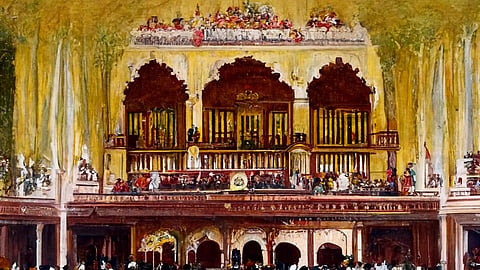- Commentary
- History Vignettes
- Notes on Culture
- Dispatches
- Podcasts
- Indian LanguagesIndian Languages
- Support

DURING A VISIT TO MYSORE, the Maharaja is said to have recorded Maha Shivan singing a passage from Dikshitar’s composition Chintayama (in Bhairavi raga) on an Edison cylinder. This had to be in 1891, the last time that Maha Shivan visited Mysore. He was intrigued to hear his own voice reproduced. We do not know his reaction.
Unfortunately, there is no trace of the Edison cylinder. It is said to have been destroyed in a fire in the Mysore Jaganmohana Palace, now a museum.
Another feature of his voice was that it never needed any practice. The voice was always ready as long as the mood was not disturbed. He was highly sensitive by nature and his family members took great care to see that nothing disturbed him. They regarded his voice as a family treasure, which it was. His elder brother Ramaswamy Shivan completely sheltered him from the affairs of the world. It is known that Patti also never practiced more than a few minutes a day of vocalizing. She learnt new roles from the score and placed them mentally, trying out a few special effects like fioritura.
Maha Shivan followed a similar method. He studied the music and grasped its details. His voice was preserved for public performance. Also, he rarely sang more than a handful of compositions by others, mainly Tyagaraja and Dikshitar. About half the program was devoted to his own and his brother’s compositions.
Here is an interesting account of his extraordinary vocal gift. The well-known Tamil scholar Swaminathan Iyer once accompanied Maha Shivan and his brother to a performance. As they were approaching the place, Maha Shivan hailed his brother in full voice, “Ramaswami, Ramaswami!” Swaminathan Iyer wondered why Maha Shivan had to call his brother by name who was walking just next to him. After the performance, he picked up enough courage to ask Ramaswamy Shivan. He replied that Maha Shivan was simply trying out his voice before the performance!
I witnessed a somewhat similar phenomenon in 1958, when M.S. Subbu Lakshmi sang for my grandfather at our home. Without bothering to warm up her voice, or even waiting for the accompanists, she began to sing. When they followed a couple of minutes later she was found to be dead on pitch.
As Maha Shivan’s voice needed no training, he had ample time on his hands to study music theory and composition and also Tamil and Sanskrit literature. 11 He was also deeply religious and was a devotee of Lord Shiva. He seems to have spent more time studying philosophic works than music. His admirers believed that he was blessed by Lord Shiva himself. He was always addressed as ‘Shivanal’ or Maha Shivan, and never by his given name of Vaidyanatha.
In his own day, he was as well-known for his exposition of Shiva Puranas or Shiva-katha at his musical recitals. It is a special art that combines musical prose and poetry with singing – something like combining recitative and arias in eighteenth century operas. On very rare occasions he gave Hari-katha performances. Shiva was his ishta devata or favorite deity, but there was no sectarianism in the man. He gave performances at Vaishnava centres also.
Although Maha Shivan observed the caste rules of the day, some of his closest friends and most patrons were not Brahmins. The person he most admired was the great Tamil scholar Meenakshi Sundaram Pillai, who was not a Brahmin.
I mention this because there is a tendency among modern writers to paint a picture of Hindu society as a caste-ridden hell in which Brahmins did nothing but oppress others. This is a grotesque caricature. They were neither the wealthiest nor the most influential group.
The idea of ‘Brahminical oppression’ is an invention of Christian missionaries of the colonial era who were attacking Brahmins and their learning as the most effective means uprooting Hinduism, in their program of converting India to Christianity. They made no secret of their plans – that the most effective method was to destroy the intellectual basis of the Hindu Civilization by attacking the Brahmins and their learning.
This continues even today when the discredited Marxist intellectuals have joined hands with the missionaries. There is also an element of cowardice – for they dare not touch either the Muslims or powerful and numerous Hindu communities like Rajputs and Yadavas. Brahmins are too small in number to retaliate in force.
In the later Brahmin and Non-Brahmin disputes, the issue was not so much ‘oppression’ as economic and job opportunities. With the destruction of the Indian economic and industrial base resulting from British colonial policies, there were few decent jobs outside the Government. These came to be dominated by Brahmins because they were the most educated class. The social structure was also disrupted with the Brahmins and their former patrons competing for the same jobs.
But the reality is quite different. Brahmins were required to follow a very strict regime simply to qualify as priests, to be called to perform religious rites. Their livelihood depended on it. For example, in eighteenth-century Mysore, Brahmins, if found drunk, could be whipped in public. They were supposed to set an example for the rest of society and uphold dharma, in return for the respect, which the community gave them. They could not afford to antagonize the rest of society on whose patronage their livelihood depended.
To be continued
The Dharma Dispatch is now available on Telegram! For original and insightful narratives on Indian Culture and History, subscribe to us on Telegram.
